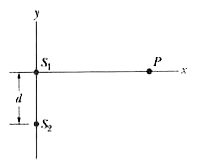Among two interfering sources, let A be ahead in phase by 54∘ relative to B. If the observations be taken from point P, such that PB−PA=1.5λ, deduce the phase difference between the waves from A and B reaching P.
The correct Answer is:3.3π
Step by step video, text & image solution for Among two interfering sources, let A be ahead in phase by 54^(@) relative to B. If the observations be taken from point P, such that PB - PA = 1.5 lambda, deduce the phase difference between the waves from A and B reaching P. by Physics experts to help you in doubts & scoring excellent marks in Class 12 exams.
Updated on:21/07/2023Topper's Solved these Questions
- WAVE OPTICSBOOK - SL ARORACHAPTER - WAVE OPTICSEXERCISE - Based on Lloyd s Mirror and Fresnel Biprism
11 Videos
- WAVE OPTICSBOOK - SL ARORACHAPTER - WAVE OPTICSEXERCISE - Based on Intensity Distribution in interference pattern
80 Videos
- WAVE OPTICSBOOK - SL ARORACHAPTER - WAVE OPTICSEXERCISE - Based on Wave nature of light
12 Videos
- UNIVERSEBOOK - SL ARORACHAPTER - UNIVERSEEXERCISE - PROBLEM_TYPE
6 Videos
Similar Questions
From two sources, sound waves of frequency 270 Hz are emitted in phase in the positive direction of an x axis. At a detector that is on the axis and 5.00 m from one source and 4.00 m from the other source, what is the phase difference between the waves (a) in radians and (b) as a multiple of the wavelength?
View SolutionFigure shows two point sources S1 and S2 that emit sound of wavelength λ = 3.00 m. The emissions are isotropic and in phase, and the separation between the sources is d = 16.0 m. At any point P on the x axis, the wave from S1 and the wave from S2 interfere. When P is very far away (x≈0) , what are (a) the phase difference between the arriving waves from S1 and S2 and (b) the type of interference they produce? Now move point P along the x axis toward S1. (c ) Does the phase difference between the waves increase or decrease? At what distance x do the waves have a phase difference of (d) 0.50λ,(e)1.00λ, and (f) 1.50λ?

View Solution
Knowledge Check
Among the two interfering monochromatic sources A and B, A is ahead of B in phase by 66∘. If the observation be taken from point P, such that PB−PA=λ/4. Then the phase difference between the waves from A and B reaching P is
A(a) 156∘B(b) 140∘C(c) 136∘D(d) 126∘Among two interfering sources, let S1 be ahead of the phase by 90∘ relative to S2 . If an observation point P is such that PS1−PS2=1.5λ , the phase difference between the waves from S1andS2 reaching P is
A3πB5π2C7π2D4πThe phase difference between two waves from successive half period zone is
Aπ/2Bπ/4CπDzero
Two point sources of sound are kept at a separation of 10 cm. They vibrate in phase to produce waves of wavelength 5.0 cm. What would be the phase difference between the two waves arriving at a point 20 cm from one source (a) on the line joining the sources and (b) on the perpendicular bisector of the line joining the sources ?
View SolutionTwo point A and B are situated at the same distance from the phase difference between the light waves passing throught A and B will be
View SolutionA wave on a stretched string is reflected from a fixed end P of the string. The phase difference, at P, between the incident and reflected waves is
View SolutionPath difference between two wavefronts emitted from coherent sources is 2.1μm. Phase difference between the wavefronts at that point is 7.692 πthe wavelength of light emitted by source will be
View SolutionThe phase difference between two points A and B on a wavefront separated by distance λ is
View Solution
